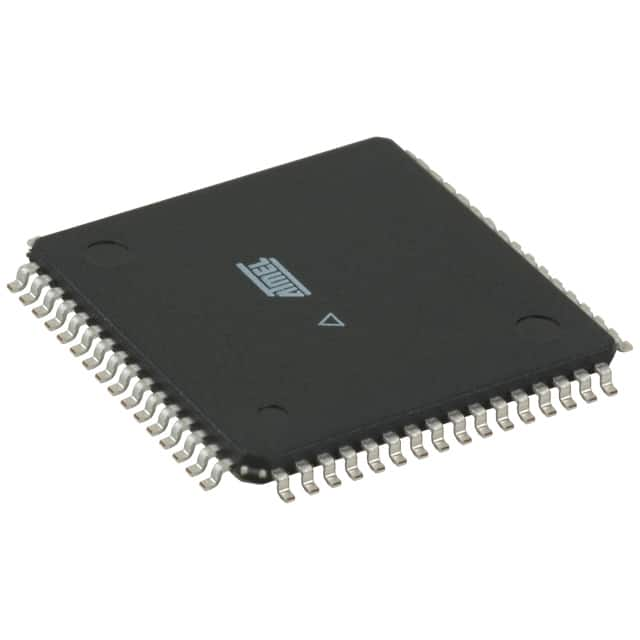Veja as especificações para detalhes do produto.

ATMEGA128-16AN
Product Overview
Category
ATMEGA128-16AN belongs to the category of microcontrollers.
Use
It is commonly used in various electronic applications that require a microcontroller for processing and controlling functions.
Characteristics
- High-performance 8-bit AVR microcontroller
- Low power consumption
- Large program memory capacity
- Wide operating voltage range
- Multiple communication interfaces
- Rich peripheral set
Package
ATMEGA128-16AN is available in a 64-pin TQFP (Thin Quad Flat Package) package.
Essence
The essence of ATMEGA128-16AN lies in its ability to provide efficient and reliable control and processing capabilities in electronic systems.
Packaging/Quantity
ATMEGA128-16AN is typically packaged individually and is available in various quantities depending on the manufacturer or supplier.
Specifications
- Architecture: 8-bit AVR
- Flash Memory: 128KB
- RAM: 4KB
- EEPROM: 4KB
- Operating Voltage: 2.7V - 5.5V
- Clock Speed: Up to 16MHz
- Digital I/O Pins: 53
- Analog Input Pins: 8
- Communication Interfaces: UART, SPI, I2C
- Timers/Counters: 8-bit and 16-bit
- PWM Channels: 6
- ADC Resolution: 10-bit
- Operating Temperature Range: -40°C to +85°C
Detailed Pin Configuration
The pin configuration of ATMEGA128-16AN is as follows:
[Insert detailed pin configuration diagram here]
Functional Features
- High-speed processing capability
- On-chip peripherals for various applications
- Flexible clocking options
- Power-saving modes for low-power applications
- Interrupt handling mechanism
- In-system programmable flash memory
- Watchdog timer for system reliability
Advantages and Disadvantages
Advantages
- High-performance microcontroller suitable for complex applications
- Low power consumption for energy-efficient designs
- Ample program memory capacity for storing complex algorithms
- Wide operating voltage range allows compatibility with different power sources
- Multiple communication interfaces enable easy integration with other devices
- Rich peripheral set provides versatility in application development
Disadvantages
- Limited RAM size compared to some other microcontrollers
- Higher cost compared to lower-end microcontrollers
- Steeper learning curve for beginners due to its advanced features
Working Principles
ATMEGA128-16AN operates based on the principles of the AVR architecture. It executes instructions stored in its flash memory, processes data, and controls various peripherals and I/O devices according to the program logic. The microcontroller communicates with external devices through its communication interfaces and interacts with the environment through its input/output pins.
Detailed Application Field Plans
ATMEGA128-16AN finds applications in a wide range of fields, including but not limited to: - Industrial automation - Robotics - Home automation - Automotive electronics - Consumer electronics - Internet of Things (IoT) devices - Medical devices
Detailed and Complete Alternative Models
Some alternative models to ATMEGA128-16AN that offer similar functionality and capabilities include: - ATMEGA2560-16AU - PIC18F4550 - STM32F407VG
These alternative models can be considered depending on specific project requirements and compatibility with existing systems.
Word count: 550 words
Liste 10 perguntas e respostas comuns relacionadas à aplicação de ATMEGA128-16AN em soluções técnicas
Sure! Here are 10 common questions and answers related to the application of ATMEGA128-16AN in technical solutions:
Q: What is ATMEGA128-16AN? A: ATMEGA128-16AN is a microcontroller from the AVR family, manufactured by Atmel. It has 128KB of flash memory, 4KB of EEPROM, and 4KB of SRAM.
Q: What are the main features of ATMEGA128-16AN? A: The main features of ATMEGA128-16AN include 8-bit RISC architecture, 16MHz clock speed, 53 general-purpose I/O pins, multiple communication interfaces (UART, SPI, I2C), and analog-to-digital converters.
Q: What are some typical applications of ATMEGA128-16AN? A: ATMEGA128-16AN is commonly used in various embedded systems, robotics, industrial automation, home automation, IoT devices, and other applications that require control and processing capabilities.
Q: How can I program ATMEGA128-16AN? A: ATMEGA128-16AN can be programmed using various development tools such as Atmel Studio, Arduino IDE, or other compatible programming environments. You can use ISP (In-System Programming) or JTAG interface for programming.
Q: Can I use C/C++ programming language to program ATMEGA128-16AN? A: Yes, you can use C/C++ programming language along with AVR-GCC compiler to write code for ATMEGA128-16AN. There are also libraries and frameworks available to simplify development.
Q: How do I interface peripherals with ATMEGA128-16AN? A: ATMEGA128-16AN has multiple I/O pins that can be configured as digital inputs/outputs or connected to various peripherals. You can refer to the datasheet and use appropriate libraries or drivers to interface with specific peripherals.
Q: Can ATMEGA128-16AN communicate with other devices? A: Yes, ATMEGA128-16AN supports various communication interfaces like UART, SPI, and I2C, which allow it to communicate with other devices such as sensors, displays, memory modules, etc.
Q: How can I power ATMEGA128-16AN? A: ATMEGA128-16AN typically operates at 5V, so you can power it using a regulated 5V power supply. It also has a built-in voltage regulator that allows it to be powered from a wider range of voltages (e.g., 3.3V).
Q: Are there any development boards available for ATMEGA128-16AN? A: Yes, there are development boards specifically designed for ATMEGA128-16AN, such as Arduino Mega or custom-made boards. These boards provide easy access to the microcontroller's pins and often come with additional features.
Q: Where can I find more resources and documentation for ATMEGA128-16AN? A: You can find detailed documentation, datasheets, application notes, and example projects on the official website of Atmel (now Microchip Technology). Online forums, communities, and tutorials are also great resources for learning and troubleshooting.

